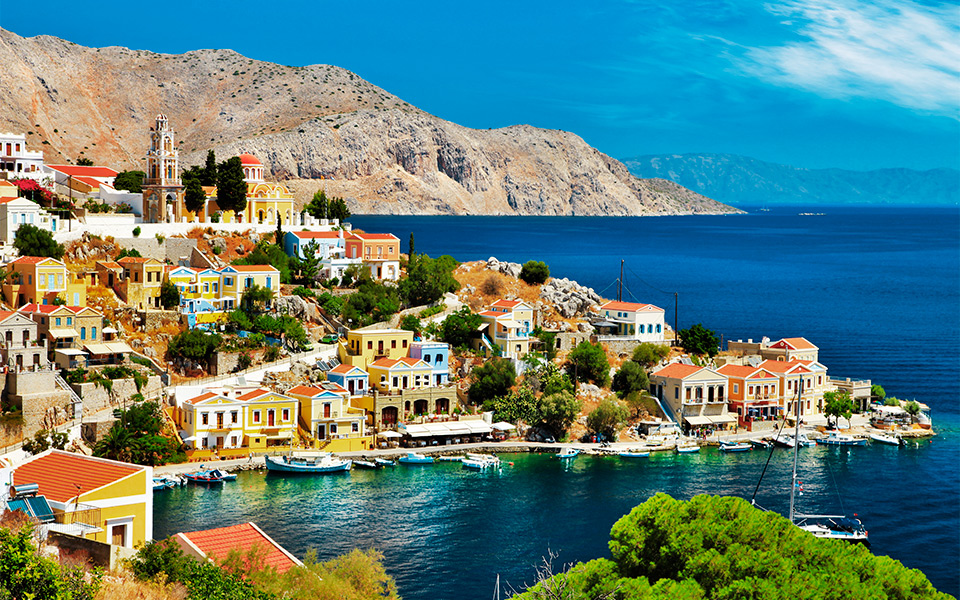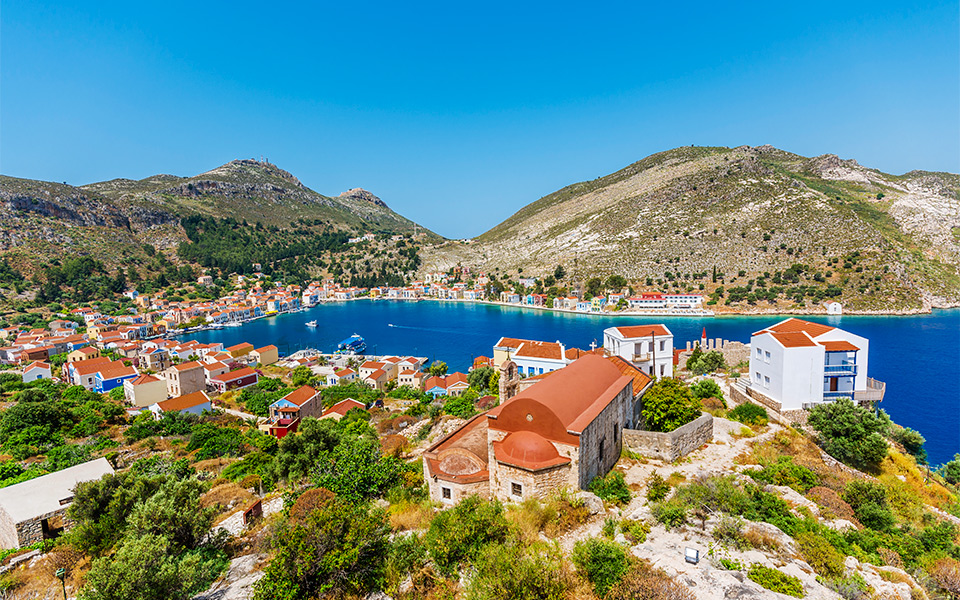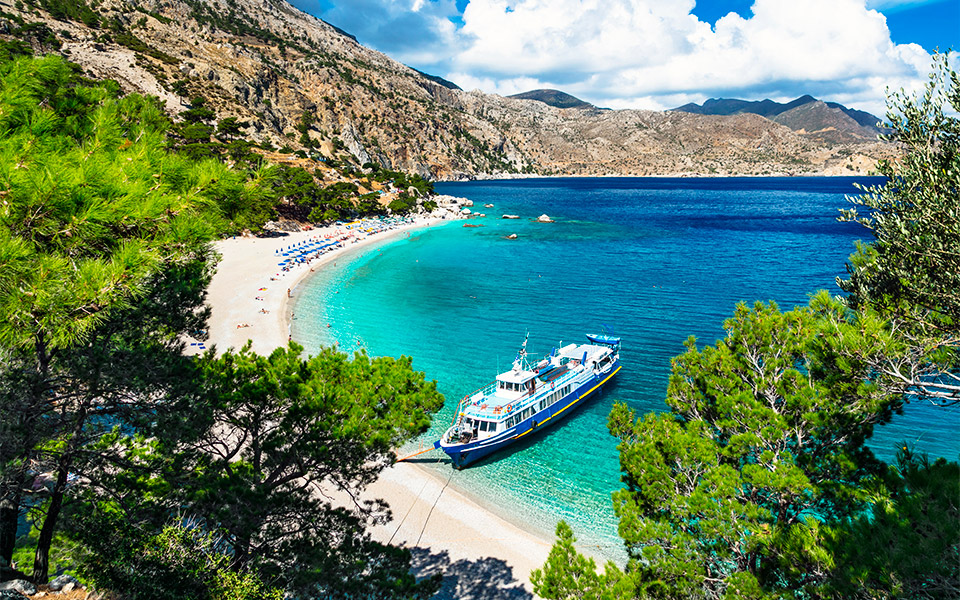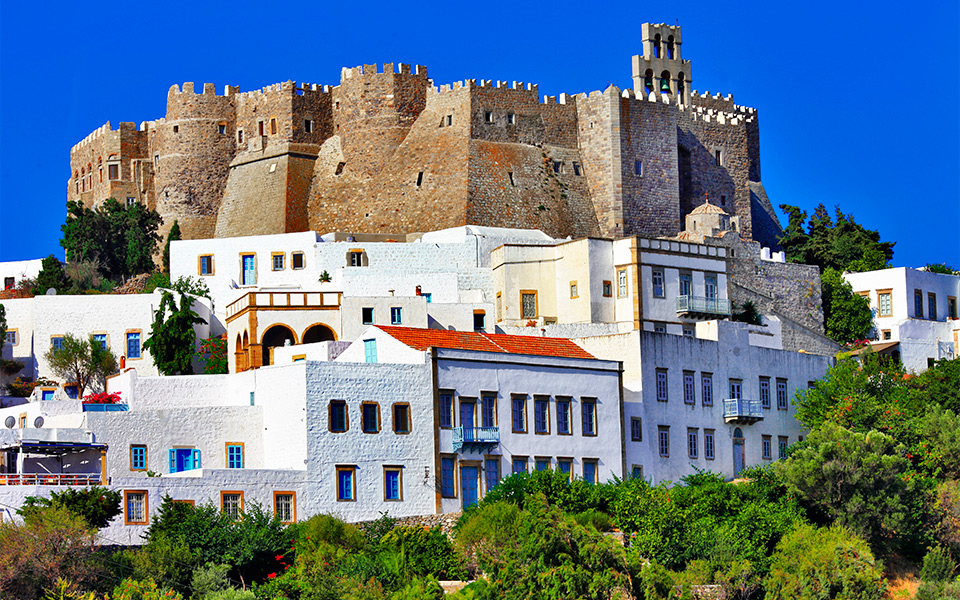The name Dodecanese in Greek literally means “twelve islands” but in truth this group in the southeastern Aegean has over 15 inhabited islands as well countless pristine uninhabited islets (many with some mind-blowing beaches).
The more famous Rhodes and Kos are, of course, well-known as international tourist destinations, but for travelers seeking to get away from package holidays and thronging beaches, any one of the five islands below could become their new favorite place in the world…

© Shutterstock
Symi – A Kaleidoscope of Color
The focal point of the island is the colorful port of Gialos. Its pink, yellow, salmon, grey and blue homes are the first things you see as the ferry pulls into the harbor. A roughly 1km promenade extends along the waterfront which is lined with yachts and small fishing boats. At one end is the large clocktower, built in 1881 – said to be a mini replica of London’s Big Ben.
Five hundred stone steps lead from Gialo to Chorio, or Ano (meaning ‘upper’) Symi. It’s not the easiest of climbs but the view from the top makes it worth the effort.
On the southern end of the island is the Archangel Michael Monastery. Dating to the 18th century, it is built on the closed bay of Panormitis in a truly magical location surrounded by green hills.
Fresh fish is in abundance here. Head to Meraklis (Gialos, Tel +30 22460.71003) to sample the local speciality of shrimp.
Where to Stay
Comfortable rooms are on offer at Odyssia Apartments (Gialos, Tel +30 22460.71210, from 80 euros).
For elegant rooms with incredible views opt for Thea (Gialos, Tel +30 22460.72559, from 80 euros).

© Shutterstock
Kastellorizo
The island that is the easternmost part of Greece offers a unique atmosphere, made with 1 part tranquility, 2 parts carefree spirit and a healthy dose of cheerfulness. This tiny island is has a population of a mere 400 residents and is quite far from even the closest Greek island (Rhodes), yet is almost swimming distance from the Turkish coast.
Its small size and remoteness means that even during the height of summer you are unlikely to run into any crowds here. Even in the large circular bay where the ferries pull in, visitors are dispersed among the various cafes and shops.
A holiday on Kastellorizo follows are fairly specific (and delightful) routine: in the morning get on one of the boats that will take you to one of the island’s incredible beaches. Return later in the afternoon for uber-fresh fish (many of the locals are amateur or professional fisherman).
You will find excellent food at Paragadi (Tel +30 694.430.7348) and Alexandra (Tel +30 22460.49019). A coffee and/or drink by the port is a must. In the evening you will gaze at the twinkling lights on the Turkish coast or stroll along the quiet alleys by the sea.
The island’s absolute must is a visit to the Blue Cave, a few minutes by boat from the village. Its small entrance is barely wide enough for a small boat, but many a brave soul has swum in its dark waters.
Where to Stay
Megisti Hotel has modern rooms with nice views (Tel +30 22460.49219, from 80 euros).
The Poseidon is housed in two neoclassical buildings near the port (Tel +30 22460.49212, from 140 euros).

© Shutterstock
Leros
A swim in pristine waters, a glass of ice-cold ouzo and a siesta in the shade of the Tamarisk trees. The classic trio of the Greek summer is undiluted on Leros. Most of the island’s swimming spots are pebble beaches – for cooler sea temperatures head to Vagia, for plentiful shade to Dio Liskaria. For empty stretches of sand opt for Gourna or Belfouti, whereas for sun loungers go to Alinda. Meanwhile Krifos and Aghia Kioura are two ‘secret’, secluded beaches for those in the know.
Breakfast is an exotic affair – pancakes with jam from locally grown guava is a specialty. for lunch / dinner try barbounia (red mullet) with rosemary, local mizithra cheese and for dessert sweet cheese pie (patsavouropita). An old local specialty is maridopitakia – small pies filled with whitebait. Dimitris at Spilia still makes these (Tel +30 22470.25626).
Aside from being the largest natural harbor in the Mediterranean, what sets Lakki apart is the architectural legacy left by the 31-year period of Italian rule of the island. A stroll through the town will take you by a number of listed buildings, such as the Agora with its clock tower, the hotel “Leros” and many homes – the so-called ‘palacinos’, which have drawn the interest of international researchers.
Sunken warplanes, cargo ships and the warship ‘Vasilissa Olga’ attract scuba divers from around the world. WWII relics can also be found in the mountains (old tunnels, cannons, wagons etc) adding a fascinating dose of modern history to hikes on the island.
Where to Stay
Panteli Beach offers furnished apartments (Tel +30 22470.26400, from 50 euros).
In Alinda enjoy a stay in the atmospheric Archontiko Angelou, a listed building from 1895 (Tel +30 694.490.8182, from 60 euros).

© Shutterstock
Karpathos – Where tradition is very much alive
When you arrive in Pigadia in Karpathos you will find a relatively modern looking town. A little further out you will come to quaint fishing villages such as Finiki with seafood restaurants by the sea. In the hills is picturesque Aperi with numerous fountains and its church dedicated to the Virgin Mary.
As you explore Karpathos’s beaches you will discover some of the best Greece has to offer in the form of Kyra-Panaghia, Achata and Apella, lapped by emerald waters. Aside from the better-known swimming spots, the island has a wealth of remote coves of incredible exotic beauty, so it is worth renting a jeep to explore the island’s rugged coastline.
Olympos is a destination unto itself. At an elevation of 285m it is not as high as its name suggests, but, as the locals say, it ‘seems to be’. Older generations of women still wear the local traditional dress on a daily basis, while others do so during festive events.
Olympos is famed for steadfastly keeping its traditions alive and while part of the motivation for this may making tourists happy, the village, with its 75 windmills and 95 churches, still smells of freshly baked bread every morning and hosts some of the most enchanting village fairs in the country.
Where to Stay
If you like big hotels check in to Alimounda Mare Hotel (Tel +30 22450.22004, from 93 euros) in Pigadia.
In Olympos, Irene’s House (Tel +30 6944-636327) has traditional-style rooms.

© Shuttestock
Patmos – A Revelation
Arion, the boho cafe near the port is a good first point of call on arriving in Patmos. To get from the port (Skala) to the Chora one option is the Aporthiani Strata, an old 2.4km paved footpath (although most people opt for the road).
Chora, built around the Monastery of the St. John the Theologian (who wrote the Book of Revelation on the island), is a revelation unto itself thanks to its incredible architecture with labyrinthine alleys passing between and even under medieval mansions. If your budget allows, as prices are not cheap, rent a house or apartment in Chora (which does not have a hotel) and surrender yourself to the island’s charms.
A 45 minute hike along the path from Diakofti or a boat will take you to Psili Ammos, the island’s remotest beach to which even electricity lines don’t reach. But if you want sun-loungers, water-sports and all the other amenities, you can also always visit the organized beaches of Petra and Grikos.
Where to Stay
A fantastic option is Patmos Aktis Suites & Spa (Tel +30 22470.32800, from 125 euros) in Grikos.
Alternatively opt for 9 Muses (Tel +30 22470.34079 from 55 euros) with rooms with sea views.











